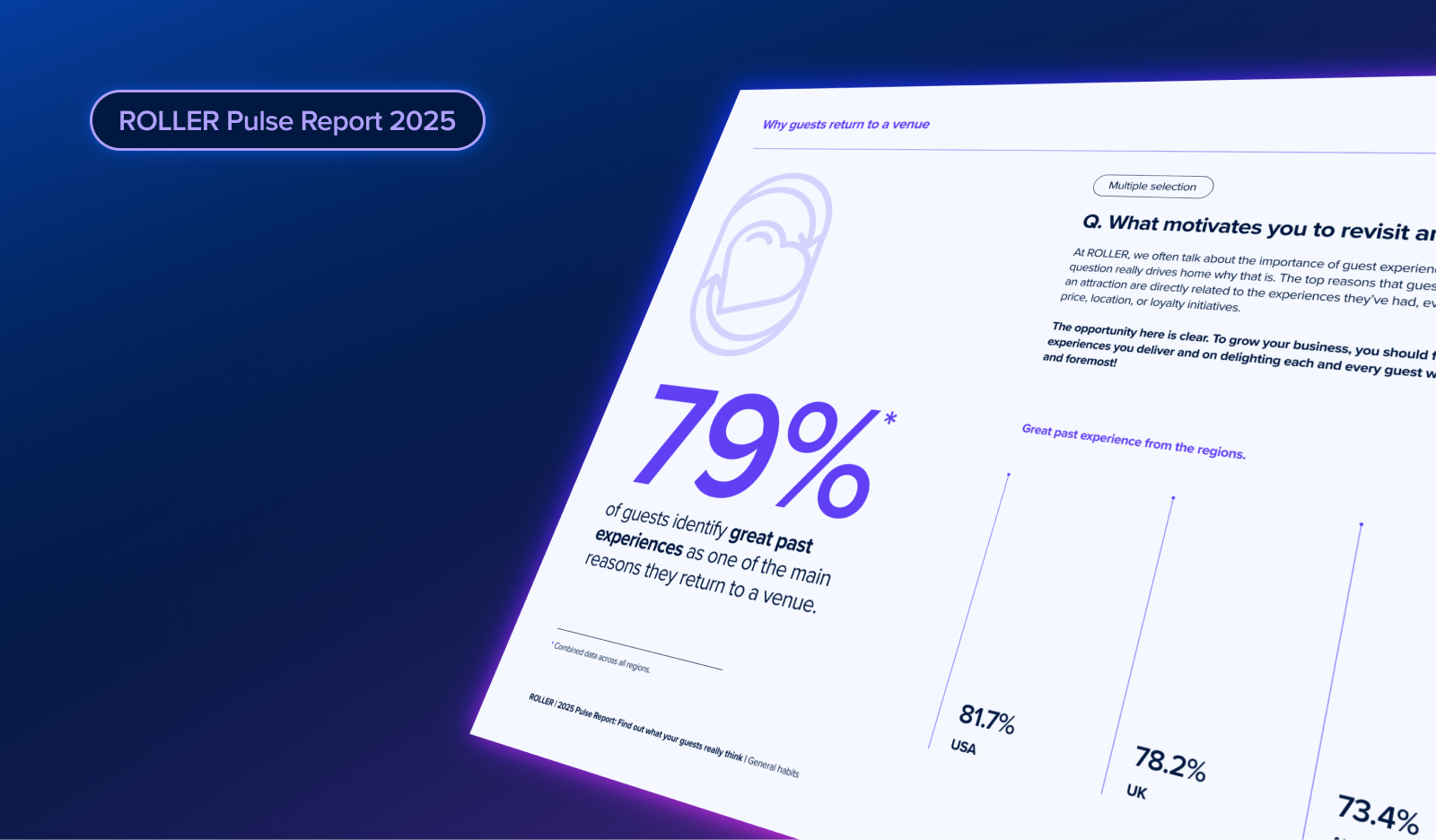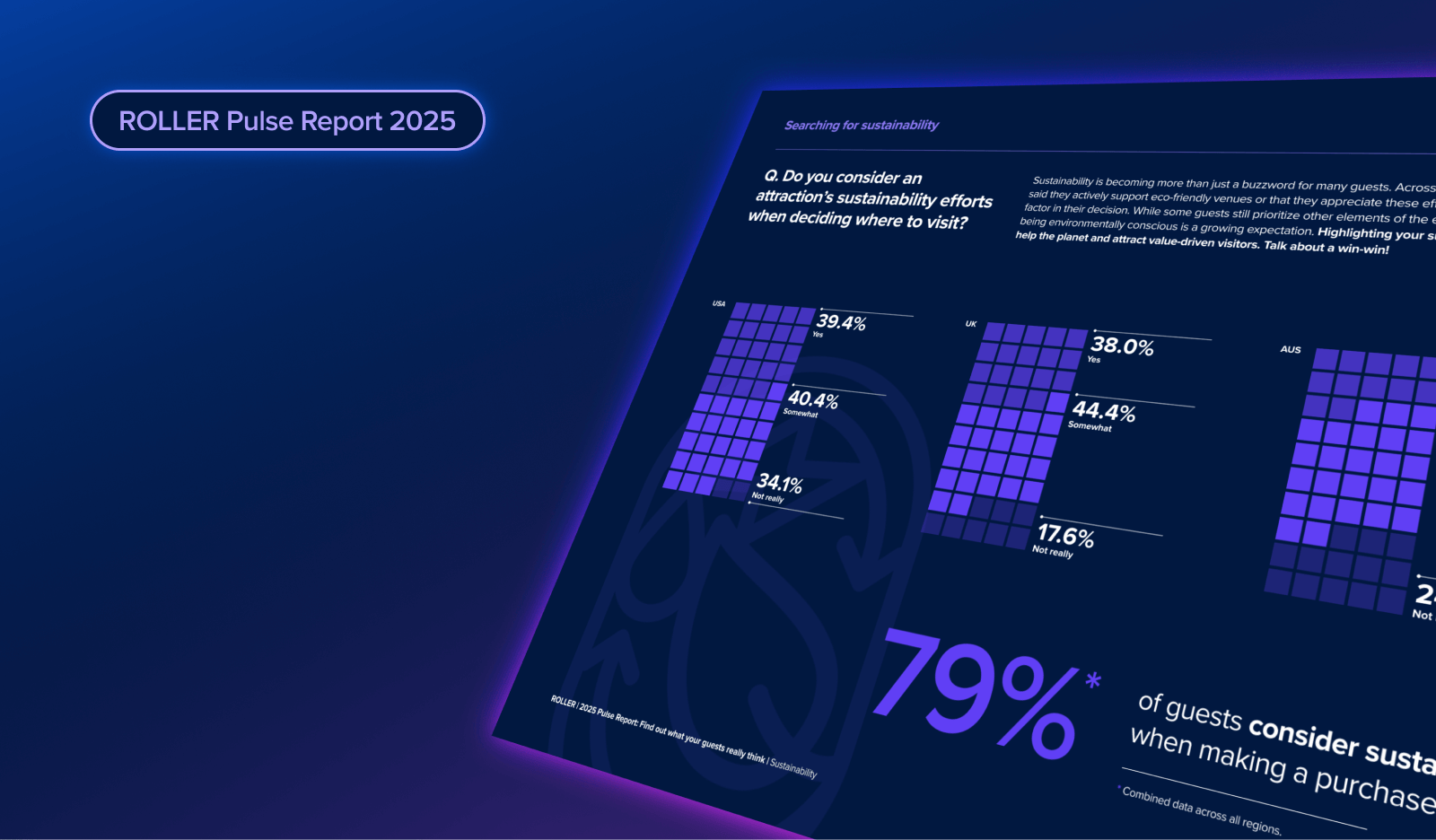How To Collect Meaningful Guest Feedback

The second installment of our Guest Experience Webinars is here, and you can find the recording below!
In the first installment of our webinar series, we spoke about the importance of creating a culture of feedback and the value it can provide your business. Today, we explore some methods that venues can use to effectively collect guest feedback. PLUS, we also discuss how to avoid some pitfalls in standard feedback collection methods.
The Guest Experience Score (GX Score) is a sentiment analysis tool ROLLER has built to help venues collect, analyze, and action guest feedback automatically. We often discuss the cornerstone of our customers' success: delivering exceptional guest experiences. And the only way this can happen is by understanding what guests want and giving it to them.
So check out this value-PACKED webinar to discover how your business can collect meaningful guest data and how the GX Score can help you truly excel.
Traditional guest feedback collection methods and associated pitfalls
Return guests spend 67% more than new ones, and keeping an existing guest is 7 times more cost-effective than acquiring a new one. Additionally, when you consider the effects of word of mouth on your business when happy guests tell others about their experience, it becomes clear that correctly measuring the guest experience is essential.
Most venue managers already know this. The problem they often face is that while this is easy to comprehend and say, it’s actually quite challenging to understand what guests really want. And this is primarily due to the methods by which venues collect feedback.
There are four main traditional methods of guest feedback collection:
- 1:1 conversations
- Online reviews
- Generic surveys
- Mystery shoppers
1:1 conversations
When selecting guests to have a one-on-one conversation with, you’re likely to pick the guests that seem most willing to talk to you. It makes sense, but selecting guests in this way will impart a bias in your feedback for two reasons:
- The guests that appear willing to talk will likely be the guests who had a positive experience at your venue, so you will not receive any constructive criticism about possible areas of improvement, and
- It’s unlikely that you’ll get honest feedback from these guests, as people generally don’t want to criticize you to your face.
Some venues will have a customer service team survey their guests. But the problem here is much the same, except now you’re also receiving filtered feedback.
Finally, when you have one-on-one conversations, you’re getting dribs and drabs of feedback, which means it’s tough to understand how your venue is performing overall.
Online reviews
Venue operators can try to rely on online reviews such as Google or Facebook, but by the time a guest leaves you this kind of feedback, it’s already publicly available, so it’s leaving guest feedback too late to remedy. Also, this feedback is much harder to resolve.
Another thing is that, more often than not, guests who had an OK experience won’t leave feedback online. And the guests who do provide online feedback often leave feedback that sits at the extreme of each spectrum — either really positive or really negative. And either way, it is often unconstructive feedback.
As such, relying on online reviews will have you missing out on critical, constructive feedback that could help your venue grow.
Generic surveys
The reality of using generic email surveys as a feedback tool is that they are often:
- Difficult to set up
- Sent at the wrong time (perhaps a week or month after a guests experience — after they have entirely forgotten their experience)
- Poorly designed, making the feedback biased or difficult to action
- Too long to complete — resulting in poor response rates
Finally, when an operator receives this kind of feedback, there’s usually no context surrounding the feedback, such as purchase history or booking information. So the venue operator must ‘connect the dots’ by themselves and try to figure out what exactly went wrong.
Mystery shoppers
Using mystery shoppers can be a great way to get feedback.
The problem is that mystery shoppers are usually costly, infrequent, and don’t give you a broader sense of guest sentiment over time.
The 3 elements of understanding guest feedback: collect, analyze, and action
1. Collect: find the best feedback collection methods
In our research, we’ve found that regardless of which of the above methods venues chose to use, none helped them collect accurate and meaningful feedback.
And if we’re talking about the big picture, collecting feedback is really only one part of the equation.
Once operators have collected their feedback, they must figure out what that feedback actually means. It’s easy to read a comment and think, “OK, one guest had a bad experience; they seemed a little fussy,” but if that comment comes up again and again, you start to develop a much greater understanding of “hey, maybe there’s something I’m missing here.” Maybe there’s a more significant trend or common feedback thread that I should address.
So then, the second element of understanding guest feedback is really being able to analyze it effectively.
2. Analyze: view the feedback and troubleshoot any problems
To properly analyze feedback, operators have to be able to determine which aspects of a guest experience impact their sentiment:
- Is it the facilities?
- Is it the service?
- Is it their sense of value for money?
- Is the venue dirty or not safe?
So in this way, breaking the experience down and analyzing what’s going on is just as important as collecting the feedback in the first place.
3. Action: action negative reviews before they compound
It may seem overwhelming to receive so much guest feedback and know what to do with it all. And when reviews are negative, it can be hard to hear.
However, the revenue opportunity of not addressing critics and not turning a critic into a fan is huge. We had one customer respond to a critic of their venue and eventually turn them into a member — now that’s how you action negative reviews!
Just think about the revenue potential of every guest that doesn’t tell you about a negative experience.
- First, you’ve lost future revenue from that guest.
- Second, you’ve also potentially lost future guests because they tell their friends about the negative experience.
- Thirdly, you have a problem you’re unaware of, so you continue to deliver a poor experience and are now on a downward spiral of lost revenue and attendance.
How to collect, analyze, and action guest feedback
1. Send timely surveys and encourage positive reviewers to leave public feedback
As mentioned, traditional survey tools are sent out infrequently or don’t have guest information attached. So they typically have poor response rates or lack essential context for your venue to learn from them.
The GX Score sends surveys to guests one hour after their session ends or at 5 pm that day. That means that the response rates to surveys are much higher, and the quality of the feedback is also much greater because the experience is fresh in the guest's mind. And the numbers prove this, with typical survey tools having a response rate in the range of 5%, compared to the GX Score’s average of 15%.
However, something more important than response rates is that because the feedback is received promptly, it impacts the number of negative reviews shared on public review sites. We’ve had customers see a 20% reduction in negative reviews on public review sites simply because, with the GX Score, guests have an outlet to voice their concerns before they jump on a social media site.
On the flip side, the GX Score tool also encourages guests who leave positive reviews to share their experiences on public review sites like Tripadvisor, Yelp, Google, and Facebook. Doing this helps venue operators boost their online reputation and Search Engine Optimization, so guests can more easily find your venue when searching for the next fun place to visit!
2. Analyze guest feedback to help make improvements where it counts
After you collect feedback from guests, the next step is to analyze that feedback and see what needs to be improved.
The GX Score tool has all your guest booking and purchase history, so you can easily filter experiences by product, such as a party booking, etc. This way, operators can dive into comments with the full context of when guests visited and what they purchased.
You can also see trends in how guest sentiment performs over time, such as on a daily or weekly basis and on particular days of the week.
And because the tool asks guests to rate their experiences across four key factors (facilities, safety and cleanliness, service, and value for money), we can also easily categorize their experiences and show you where your guest experience could be improved.
Finally, taking it one step further, we’ve integrated party hosts into the system, so you can see how guests rate particular staff members and how they compare to one another over time.
3. Action guest feedback and convert critics into fans
To help you convert your critics into fans, the GX Score makes it easy to action guest feedback with instant email alerts on negative feedback that include guests booking details, a click-to-call button, and their purchase history. This way, your staff can follow up with unhappy guests instantly and hopefully turn them from critics to members to superfans!
Before we sign off today, there’s a final new feature that we’re excited to share with you! We’ve just released an open API that allows venues to take guest feedback and integrate it into their marketing campaigns! So, for example, you could segment all those happy guests into a paid membership campaign or segment guests who haven’t visited for a while into a win-back campaign.
We hope this webinar was informative and that you enjoyed yourself while learning too! You can learn more about ROLLER’s GX Score here.
Related articles

.png)
What the 2025 Pulse Report Reveals About Guest Booking Behavior at Attractions

2025 Pulse Report: How Sustainability Is Shaping Guest Expectations
Enhance your guest experience
Get free education, tips and inspiration to help you run a successful venue.
